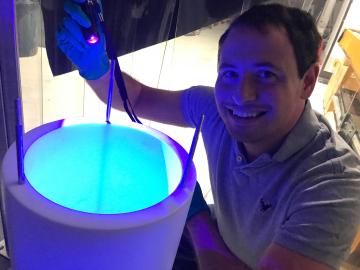
Filter News
Area of Research
- (-) Materials (62)
- (-) Neutron Science (26)
- Advanced Manufacturing (5)
- Biology and Environment (26)
- Computational Biology (1)
- Computational Engineering (2)
- Computer Science (9)
- Electricity and Smart Grid (1)
- Energy Science (40)
- Functional Materials for Energy (1)
- Fusion and Fission (9)
- Fusion Energy (7)
- Materials for Computing (4)
- Mathematics (1)
- National Security (14)
- Nuclear Science and Technology (13)
- Nuclear Systems Modeling, Simulation and Validation (1)
- Quantum information Science (9)
- Supercomputing (69)
News Topics
- (-) Advanced Reactors (5)
- (-) Artificial Intelligence (12)
- (-) Clean Water (4)
- (-) Composites (9)
- (-) Physics (30)
- (-) Quantum Science (15)
- 3-D Printing/Advanced Manufacturing (27)
- Big Data (3)
- Bioenergy (16)
- Biology (11)
- Biomedical (20)
- Biotechnology (1)
- Buildings (5)
- Chemical Sciences (34)
- Computer Science (24)
- Coronavirus (13)
- Critical Materials (13)
- Cybersecurity (5)
- Energy Storage (38)
- Environment (21)
- Exascale Computing (2)
- Fossil Energy (1)
- Frontier (4)
- Fusion (8)
- Grid (5)
- High-Performance Computing (6)
- Hydropower (1)
- Irradiation (1)
- Isotopes (13)
- ITER (1)
- Machine Learning (7)
- Materials (80)
- Materials Science (87)
- Mathematics (1)
- Microscopy (27)
- Molten Salt (3)
- Nanotechnology (43)
- National Security (4)
- Neutron Science (127)
- Nuclear Energy (18)
- Partnerships (11)
- Polymers (18)
- Quantum Computing (4)
- Security (3)
- Simulation (1)
- Space Exploration (5)
- Summit (6)
- Transportation (19)
Media Contacts

A study led by researchers at ORNL could help make materials design as customizable as point-and-click.

ORNL, TVA and TNECD were recognized by the Federal Laboratory Consortium for their impactful partnership that resulted in a record $2.3 billion investment by Ultium Cells, a General Motors and LG Energy Solution joint venture, to build a battery cell manufacturing plant in Spring Hill, Tennessee.

Ten scientists from the Department of Energy’s Oak Ridge National Laboratory are among the world’s most highly cited researchers, according to a bibliometric analysis conducted by the scientific publication analytics firm Clarivate.

A team led by the U.S. Department of Energy’s Oak Ridge National Laboratory demonstrated the viability of a “quantum entanglement witness” capable of proving the presence of entanglement between magnetic particles, or spins, in a quantum material.

A team led by the ORNL has found a rare quantum material in which electrons move in coordinated ways, essentially “dancing.”

An ORNL-led team comprising researchers from multiple DOE national laboratories is using artificial intelligence and computational screening techniques – in combination with experimental validation – to identify and design five promising drug therapy approaches to target the SARS-CoV-2 virus.

Sergei Kalinin, a scientist and inventor at the Department of Energy’s Oak Ridge National Laboratory, has been elected a fellow of the Microscopy Society of America professional society.

At the Department of Energy’s Oak Ridge National Laboratory, scientists use artificial intelligence, or AI, to accelerate the discovery and development of materials for energy and information technologies.

Using complementary computing calculations and neutron scattering techniques, researchers from the Department of Energy’s Oak Ridge and Lawrence Berkeley national laboratories and the University of California, Berkeley, discovered the existence of an elusive type of spin dynamics in a quantum mechanical system.

The COHERENT particle physics experiment at the Department of Energy’s Oak Ridge National Laboratory has firmly established the existence of a new kind of neutrino interaction.


